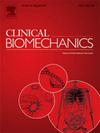斜行腰椎间融合间接减压的生物力学模型--有限元研究
IF 1.4
3区 医学
Q4 ENGINEERING, BIOMEDICAL
引用次数: 0
摘要
背景斜腰椎椎间融合术旨在通过椎体间融合器笼为脊神经减压,但最佳手术策略,包括针对特定患者特征选择植入物,仍不明确。我们建立了一个生物力学模型,以评估病理生理特征和器械如何影响脊柱对位、间接减压和椎间融合器笼下沉风险。模拟了五例骨密度正常或骨质疏松、初始椎间盘高度为 4.3 至 8.3 毫米的 I 级脊柱滑脱病例。对椎弓根高度为 10、12 和 14 毫米(后凸 12°)的斜腰椎椎间融合术进行了研究。评估了术后椎间盘高度、椎孔和椎管尺寸、节段前凸和椎体滑移的变化。研究结果腰椎间融合术明显改善了术后椎间盘高度、椎管和椎间孔的尺寸,14 毫米的椎体保持架改善最大。与独立结构相比,双侧椎弓根螺钉固定明显降低了皮质终板应力和位移,而更大直径的螺钉杆也带来了更多益处。低骨密度会使位移增加 63%。使用6毫米杆进行双侧椎弓根螺钉固定可最大限度地减少终板应力和位移,尤其是在骨质疏松的病例中。未来的研究将验证这些发现,并探索该模型在手术规划方面的潜力。本文章由计算机程序翻译,如有差异,请以英文原文为准。
Biomechanical modelling of indirect decompression in oblique lumbar intervertebral fusions – A finite element study
Background
Oblique lumbar intervertebral fusion aims to decompress spinal nerves via an interbody fusion cage, but the optimal surgical strategy, including implant selection for specific patient characteristics, remains unclear. A biomechanical model was developed to assess how pathophysiological characteristics and instrumentation impact spinal realignment, indirect decompression, and cage subsidence risk.
Methods
A finite element model of the L4-L5 segment was derived from a validated asymptomatic T1-S1 spine model. Five cases of grade I spondylolisthesis with normal or osteoporotic bone densities and initial disc heights of 4.3 to 8.3 mm were simulated. Oblique lumbar intervertebral fusion with cage heights of 10, 12, and 14 mm (12° lordosis) was examined. Postoperative changes in disc height, foraminal and spinal canal dimensions, segmental lordosis, and vertebral slip were assessed. Vertebral stresses and displacements under 10 Nm flexion and 400 N gravitational load were compared between stand-alone constructs and bilateral pedicle screw fixation using rods of 4.75, 5.5, and 6 mm diameters.
Findings
Oblique lumbar intervertebral fusion significantly improved postoperative disc height, foraminal and spinal canal dimensions, with the greatest enhancements observed with 14 mm cages. Bilateral pedicle screw fixation markedly reduced cortical endplate stresses and displacements compared to stand-alone constructs, with added benefits from larger rod diameters. Low bone density increased displacements by 63 %.
Interpretation
Thicker cages achieve better decompression but increase subsidence risk. Bilateral pedicle screw fixation with 6 mm rods minimizes endplate stresses and displacements, especially in osteoporotic cases. Future research will validate these findings and explore the model's potential for surgical planning.
求助全文
通过发布文献求助,成功后即可免费获取论文全文。
去求助
来源期刊

Clinical Biomechanics
医学-工程:生物医学
CiteScore
3.30
自引率
5.60%
发文量
189
审稿时长
12.3 weeks
期刊介绍:
Clinical Biomechanics is an international multidisciplinary journal of biomechanics with a focus on medical and clinical applications of new knowledge in the field.
The science of biomechanics helps explain the causes of cell, tissue, organ and body system disorders, and supports clinicians in the diagnosis, prognosis and evaluation of treatment methods and technologies. Clinical Biomechanics aims to strengthen the links between laboratory and clinic by publishing cutting-edge biomechanics research which helps to explain the causes of injury and disease, and which provides evidence contributing to improved clinical management.
A rigorous peer review system is employed and every attempt is made to process and publish top-quality papers promptly.
Clinical Biomechanics explores all facets of body system, organ, tissue and cell biomechanics, with an emphasis on medical and clinical applications of the basic science aspects. The role of basic science is therefore recognized in a medical or clinical context. The readership of the journal closely reflects its multi-disciplinary contents, being a balance of scientists, engineers and clinicians.
The contents are in the form of research papers, brief reports, review papers and correspondence, whilst special interest issues and supplements are published from time to time.
Disciplines covered include biomechanics and mechanobiology at all scales, bioengineering and use of tissue engineering and biomaterials for clinical applications, biophysics, as well as biomechanical aspects of medical robotics, ergonomics, physical and occupational therapeutics and rehabilitation.
 求助内容:
求助内容: 应助结果提醒方式:
应助结果提醒方式:


